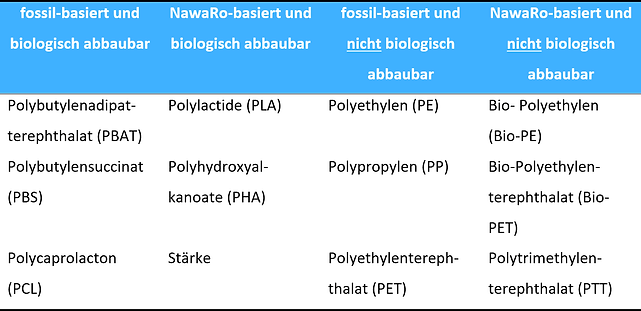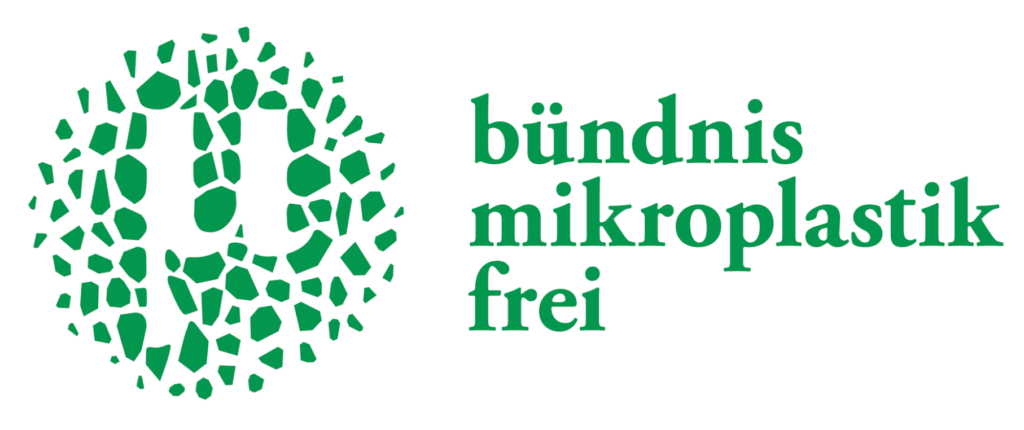"Bio" plastics
Due to the growing environmental pollution caused by plastics and the resulting ever-increasing impact on the environment, so-called "plastic waste" has been gaining ground in recent times. "Bio" plastics as a supposedly environmentally friendly alternative to conventional types of plastic are becoming increasingly important. "Bio" plastics can be obtained from renewable raw materials or be compostable or even both. Especially with regard to global societal challenges such as climate change and the finite nature of fossil resources, the development towards a bio-based economy is receiving more and more attention from politics and research.
In the context of a current study on the assessment of "bio" plastics among the population and buyers in Germany, Scherer et al. (2020) pointed out that the use of "bio" plastics is not a problem, that buyers show a very high intention to prefer products made from "organic" plastics in purchasing decisions.
However, the term "bio" plastics is not uniformly defined. It is problematic that the word component "bio" has a alleged Environmental friendliness which does not necessarily apply in every case here (WWF Germany 2021).
The term "bio" plastic is used for a variety of different polymers and can have a Reference to production from renewable raw materials or potential biodegradability or both.
Zimmermann et al. (2020) recently showed that in 80 per cent of biobased and biodegradable products (e.g. drinking bottles, chocolate packaging etc.) contained more than 1000 substances, some of which showed toxic effects in cell culturesPlant-based products made from cellulose and starch would contain the most chemicals.
Biodegradable, bio-based or both?
The property Biodegradable describes that a material can be converted into natural substances (e.g. water, carbon dioxide, compost) by microorganisms present in the environment without the need for additional chemical additives.
The terminology bio-based describes that a material has been obtained on the basis of biomass or renewable raw materials (e.g. vegetable substances such as sugar, starch, vegetable oils or cellulose).
According to Fraunhofer UMSICHT (2022), in line with the above criteria, the following can be identified Four groups of bioplastics derive:
- Non-biodegradable plastics from fossil raw materials
- Non-biodegradable plastics from renewable raw materials
- Biodegradable plastics from fossil raw materials
- Biodegradable plastics from renewable raw materials
Biodegradability of plastics and bioplastics
Basically, not all plastics made from renewable raw materials are biodegradable, whereby different degradation times must also be taken into account. Some plastics made from petrochemical (fossil) raw materials, on the other hand, can be biodegraded. Table 1 provides an overview of examples of different types of plastics and bioplastics along with their biodegradability.
Table 1: Plastic types with examples

Current discourses on bioplastics
Biobased or biodegradable materials are not necessarily less harmful than conventional plastics, as Zimmermann et al. (2020) recently showed.
Like conventional plastics, three quarters of all products examined contained harmful additives, such as substances that have a toxic effect on cells or cause hormone-like effects. The above-mentioned author group emphasises the need for further studies in the course of risk research on plastics and their alternatives. Here is strongly recommends that full transparency on all ingredients of each product be made mandatory. is so that health risks can be ruled out. Zimmermann et al. (2019, 2020) found only low inherent toxicity in about a quarter of the samples. This selection could lead the way for the future development of a new generation of low-toxic and environmentally friendly plastics.
Many of the bioplastics that are currently labelled as biodegradable can only be degraded under specific conditions that do not necessarily exist in the natural environment.
In most industrial composting plants, the decomposition times for biodegradable plastics are too shortso that, despite appropriate certification, biodegradable products do not decompose sufficiently.
They have to be sorted out at great expense and are finally incinerated.
- Current standards that certify degradability are criticised because, among other things, they do not guarantee complete degradation and also do not take into account the degradability of the numerous additives, so-called additives, which determine the properties of the plastic.
- The question arises as to whether consumers are basically informed enough to correctly weigh up or decide how "bio" plastics are to be adequately disposed of. It is very likely that some of the non-degradable or poorly degradable "bio" plastics are disposed of via waste, especially compost.
- Consumers are led to believe that plastic production can continue because plastic is still used for many single-use products (business as usual) instead of systematically switching to unpackaged and reusable as the standard.
- The production of "bio" plastics - as with conventional plastics - is energy-intensive and generates greenhouse gases. It is therefore desirable to significantly reduce the production and use of all types of plastic in the sense of the circular economy (reduce-reuse-recycle).
- Biodegradable plastics are also not useful in the sense of a circular economy, because they remove a renewable raw material that has been produced at great expense from the cycle. Only the longest possible use - i.e. remaining in the cycle - is sustainable and resource-conserving.
- If disposable packaging cannot be dispensed with, for example for hygienic reasons, packaging made from recycled plastics is recommended instead of packaging made from renewable raw materials.
Conclusion
On 2 March 2022, 193 member states in the United Nations Environment Assembly (UNEA) decided toThe aim of the report is to phase out the introduction of new plastic into the environment, probably by 2030.
Such a new global agreement should cover the entire life cycle of plasticsincluding raw material extraction, production, transport, use, disposal and remediation.
It is to be feared that "bio" plastics will increasingly gain attention in the near future, especially in the medical sector, without adequate labelling and broad education on these innovative types of plastics. "Bio" plastics, especially bio-based and biodegradable "bio" plastics, can be an alternative to conventional plastics, the use of these types of plastic, however, is unlikely to be the way out of the plastic crisis in its current form.
Further information on the topic can be found here:
- BUND e.V.: "Organic" plastic raises false hopes
- Rosenboom JG, Langer R, Traverso G. Bioplastics for a circular economy. Nature Reviews Materials 7, 117-137 (2022). https://doi.org/10.1038/s41578-021-00407-8
Behnsen H, Endres H-J (2020): Bioplastics - Background. In: Endres H-J, Mudersbach M, Behnsen H, Spierling S (eds.): Bioplastics from the Perspective of Sustainability and Communication: Status quo, Opportunities and Challenges. Springer Fachmedien Wiesbaden, Wiesbaden: 7-16.
Fraunhofer UMSICHT (2022): Bioplastics. Available at: https://www.umsicht.fraunhofer.de/de/ueber-fraunhofer-umsicht/nachhaltigkeit/nationale-informationsstelle-nachhaltige-kunststoffe/polymere-kunststoff/biokunststoffe.html#1 [last access: 10.02.2022].
Kržan A (2012): Biodegradable polymers and plastics. Available at: https://icmpp.ro/sustainableplastics/files/Biodegradable_plastics_and_polymers.pdf [last access: 17.02.2022].
Patermann C, Aguilar A (2018): The origins of the bioeconomy in the European Union. New biotechnology, 40: 20-24.
Scherer C, Klein F, Emberger-Klein A, Menrad K (2020): Assessment of bioplastics in the population and among buyers in Germany. In: Endres H-J, Mudersbach M, Behnsen H, Spierling S (eds.): Bioplastics from the Perspective of Sustainability and Communication: Status quo, Opportunities and Challenges. Springer Fachmedien Wiesbaden, Wiesbaden: 159-181.
Spangenberg J, Kuhlmann W (2020): R&D project "Bioeconomy in the light of sustainability and the implementation of the SDGs" (FKZ 3520890900). Available at: https://www.bund.net/fileadmin/user_upload_bund/publikationen/ressourcen_und_technik/ressourcen_technik_biooekonomie_projekt_studie_spangenberg.pdf [last access: 17.02.2022].
WWF Germany (2021): Bioplastics. Available at: https://www.wwf.de/themen-projekte/landwirtschaft/bioenergie/bioplastik [last access: 17.02.2022].
Zimmermann L, Dombrowski A, Völker C, Wagner M (2020): Are bioplastics and plant-based materials safer than conventional plastics? In vitro toxicity and chemical composition. Environment International, 145: 106066.
Zimmermann L, Dierkes G, Ternes TA, Völker C, Wagner M (2019): Benchmarking the in vitro toxicity and chemical composition of plastic consumer products. Environ. Sci. Technol. 53 (2019) 11467-11477. https://doi.org/10.1021/acs.est.9b02293







